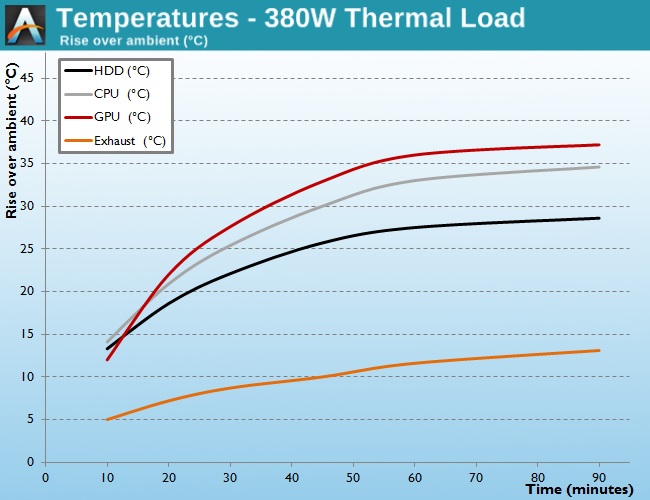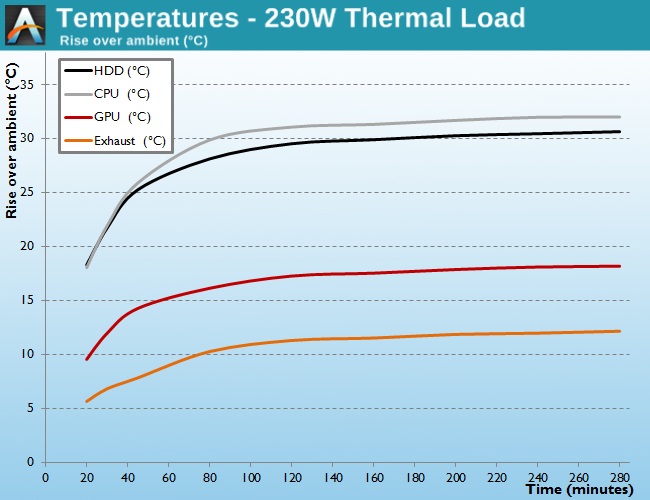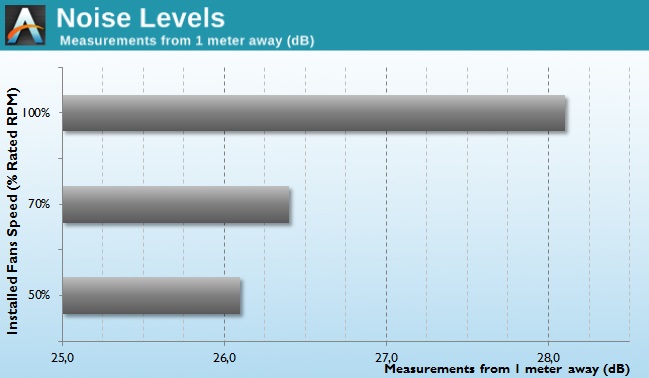Corsair Obsidian 250D Case Review
by E. Fylladitakis on January 21, 2014 12:00 PM EST- Posted in
- Cases/Cooling/PSUs
- Corsair
- Mini ITX
- Case
Test setup
We've reworked our computer case testing methodology to improve on how systems are tested, so as our first Mini-ITX case for the new setup we don't have comparitive results.
Professional testing requires the emulation of real-world situations but with repeatable results; thus, a perfectly controllable test setup and environment is desired, especially for comparable results. Testing the thermal performance of any case with a typical real-world setup technically limits the comparability of the results to this setup alone, as an active system interacts with its environment and the change of a single component can alter myriads of variables. As such, we developed synthetic loads that emulate the thermal output of real systems, with the benefit being that the outputs and loads are passive, steady and quantifiable. As such, the thermal testing now displays the thermal capabilities of the case alone, as if it would have to deal with the entire thermal load by itself, regardless of the system that would be installed inside it.
Laboratory data loggers are being used to monitor the PT100 sensors and control the safety relays, which are fully accessible via our custom software. Three such loads have been developed; the Mini-ITX version simulates a 150 W CPU, 30 W VRM, 20 W RAM and 1 × 120 W GFX card thermal load. Finally, 3.5" HDD dummy loads have also been created, with two of them installed in the Mini-ITX case. Each of them converts 30 W of electrical power to thermal, bringing the total thermal load of the ITX test setup up to 380 Watts. As such, the thermal load is very high and only the best of cases will be able to handle it for more than a few minutes. We are also performing a test with a thermal load of 230W, by removing the VRM and RAM heaters, one disk and using a low-profile, 50 W version GFX load, for comparison with compact Mini-ITX cases that cannot take a full size GFX card at all.
Thermal testing has been performed with all of the case's stock fan operating at maximum speed. Noise testing has been performed with a background noise level of 22.4dB(A).
Results and discussion
Despite the rather slow stock fans, the size and mass of the Corsair Obsidian 250D allows for excellent performance figures. The high-performance Mini-ITX case can easily tackle a passive thermal load of 380W, which is considered to be massive for a Mini-ITX system. Such is the thermal inertia of the case that the temperatures did not stabilize even after over an hour of testing. The temperatures beneath the GFX load are higher than around the CPU area, as the passive thermal load does not interact with its environment and the design expects a GFX cooler to be sucking air from the side panel of the case.
This means that while the Obsidian 250D will work optimally with any GFX card that has a fan, passive GFX cards will be receiving little to no aid by the bulk airflow of the case. This however also stands true for the components of the card that are not being cooled by the card's heatsink, such as secondary heatsinks (i.e. RAM, VRM), passive components, etc. The design also offers little airflow to the HDD cage, which however has ventilation openings on all sides, thus the temperatures remain at good levels during our testing. This also becomes apparent during our 230 Watt load test, as the temperature of the HDD load almost reaches that of the CPU area, despite being less than half the thermal magnitude.
As Corsair apparently installed two of the slowest, quietest fans they could find, the stock cooling of the Obsidian 250D largely relies on the size of the fans and the size of the case. The result is a very quiet running system, as the sound of the fans is only noticeable in an entirely silent room and while they are running at maximum speed. Most single 3.5" HDDs are noisier than the stock cooling fans of the Obsidian 250D. Reducing the speed of the fans does decrease the readings of our instruments, although the change was unnoticeable to a human ear from 1 meter away, as the system appeared entirely silent to begin with. To give you a practical equivalent of the 26.1 dB(A) that our meter registered one meter away from the Obsidian 250D, that's corresponding of a whisper at about 70 cm away.













52 Comments
View All Comments
lmcd - Tuesday, January 21, 2014 - link
It's pretty rare these days to find a board without USB 3.0. However I have seen one or two cheaper models unequipped. But again the niche is small and irrelevant in this case so while Spidey clearly is overreacting, the absence of an adapter isn't a big deal either.spidey81 - Tuesday, January 21, 2014 - link
I didn't mean to seem overreacting, but the reviewer is clearly biasing this case as an HTPC and not what it's geared toward. It's a gaming or enthusiast case. It is built to house high end components and cool them as such. It's not a low power HTPC nor suited for budget oriented builds. I agree with other commenters on here about the focus of the article and the intentions of the reviewer going into this review.vision33r - Tuesday, January 21, 2014 - link
Ugly case, the Bitfenix Prodigy is much better and just as flexible to mod if not better because of the drive cage design is better.dingetje - Tuesday, January 21, 2014 - link
yes, Bitfenix prodigy, phenom and colossus look nicer but are kinda big and, like the 250D, are not exactly budget.People who are looking for budget options should check out the cooler master elite 130 and the even smaller elite 110. They get my vote.
Bob Todd - Thursday, January 23, 2014 - link
The 130 looks like a nice update to the 120, glad they finally went all black with the front. The 120 was one of the better mITX case deals around. I picked up one for $40 and a second more recently (but before the 130 came out) for $35. Excellent case at those price points and plenty of room inside for a nice GPU without being too tall for HTPC usage.dingetje - Tuesday, January 21, 2014 - link
^ and I hope anandtech will review them :)smartthanyou - Tuesday, January 21, 2014 - link
Speaking for myself, it would be incredibly helpful to have some sort of frame of reference, in regards to size, when you show pictures of the exterior of the case. I am not sure what that should be, maybe a ruler laying horizontally and one vertically, or possibly using transparency to overlay pictures of a couple of competing cases.I would be curious how others feel but the exterior shots really don't give any sense of size.
kyuu - Tuesday, January 21, 2014 - link
I agree, a sense of scale would be very welcome. I can't really visualize how big/small this case really is without some context.wperry - Friday, January 24, 2014 - link
I had the same complaint/criticism with the review of the ASRock M8. Particularly with Mini ITX, size is very important factor and, for that, I need some sense of scale. NCASE had a really simple solution - put a soda can next to their case (or mock-up).J.Griff - Tuesday, January 21, 2014 - link
Fractal Design node 304 looks like it still remain king, nice try Corsair.